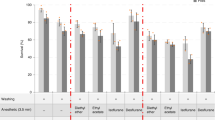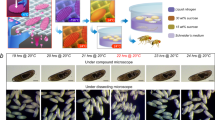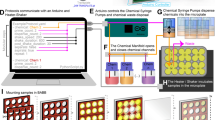Abstract
This protocol describes a method for the dissection of egg chambers from intact Drosophila females and culture conditions that permit live imaging of them, with a particular emphasis on stage 9. This stage of development is characterized by oocyte growth and patterning, outer follicle cell rearrangement and migration of border cells. Although in vitro culture of egg chambers of later developmental stages has long been possible, until recently stage 9 egg chambers could only be kept alive for short periods, did not develop normally, and border cell migration failed entirely. We have established culture conditions that support overall egg chamber development including border cell migration in vitro. This protocol makes possible direct observation of molecular and cellular dynamics in both wild-type and mutant egg chambers, and opens the door to testing of pharmacological inhibitors and the use of biosensors. The entire protocol takes ∼24 h while the preparation of egg chambers for live imaging requires only 15–20 min.
This is a preview of subscription content, access via your institution
Access options
Subscribe to this journal
Receive 12 print issues and online access
$259.00 per year
only $21.58 per issue
Buy this article
- Purchase on Springer Link
- Instant access to full article PDF
Prices may be subject to local taxes which are calculated during checkout




Similar content being viewed by others
References
Nystul, T.G. & Spradling, A.C. Breaking out of the mold: diversity within adult stem cells and their niches. Curr. Opin. Genet. Dev. 16, 463–468 (2006).
Horne-Badovinac, S. & Bilder, D. Mass transit: epithelial morphogenesis in the Drosophila egg chamber. Dev. Dyn. 232, 559–572 (2005).
Grunert, S. & St Johnston, D. RNA localization and the development of asymmetry during Drosophila oogenesis. Curr. Opin. Genet. Dev. 6, 395–402 (1996).
Nüsslein-Volhard, C. & Roth, S. Axis determination in insect embryos. Ciba Found. Symp. 144, 37–55 discussion 55–64, 92–98 (1989).
Schüpbach, T. & Roth, S. Dorsoventral patterning in Drosophila oogenesis. Curr. Opin. Genet. Dev. 4, 502–507 (1994).
Hudson, A.M. & Cooley, L. Understanding the function of actin-binding proteins through genetic analysis of Drosophila oogenesis. Annu. Rev. Genet. 36, 455–488 (2002).
Montell, D.J. The social lives of migrating cells in Drosophila. Curr. Opin. Genet. Dev. 16, 374–383 (2006).
Rørth, P. Initiating and guiding migration: lessons from border cells. Trends Cell Biol. 12, 325–331 (2002).
Cha, B.J., Koppetsch, B.S. & Theurkauf, W.E. In vivo analysis of Drosophila bicoid mRNA localization reveals a novel microtubule-dependent axis specification pathway. Cell 13, 35–46 (2001).
Lee, S. & Cooley, L. Jagunal is required for reorganizing the endoplasmic reticulum during Drosophila oogenesis. J. Cell Biol. 176, 941–952 (2007).
Bohrmann, J. & Biber, K. Cytoskeleton-dependent transport of cytoplasmic particles in previtellogenic to mid-vitellogenic ovarian follicles of Drosophila: time-lapse analysis using video-enhanced contrast microscopy. J. Cell Sci. 107, 849–858 (1994).
Bai, J., Uehara, Y. & Montell, D.J. Regulation of invasive cell behavior by taiman, a Drosophila protein related to AIB1, a steroid receptor coactivator amplified in breast cancer. Cell 103, 1047–1058 (2000).
Silver, D.L. & Montell, D.J. Paracrine signaling through the JAK/STAT pathway activates invasive behavior of ovarian epithelial cells in Drosophila. Cell 107, 831–841 (2001).
Duchek, P. & Rørth, P. Guidance of cell migration by EGF receptor signaling during Drosophila oogenesis. Science 291, 131–133 (2001).
Geisbrecht, E.R. & Montell, D.J. Myosin VI is required for E-cadherin-mediated border cell migration. Nat. Cell Biol. 4, 616–620 (2002).
Geisbrecht, E.R. & Montell, D.J. A role for Drosophila IAP1 mediated caspase inhibition in Rac-dependent cell migration. Cell 118, 111–125 (2004).
Starz-Gaiano, M. & Montell, D.J. Genes that drive invasion and migration in Drosophila. Curr. Opin. Genet. Dev. 14, 86–91 (2004).
Montell, D.J., Rørth, P. & Spradling, A.C. Slow border cells, a locus required for a developmentally regulated cell migration during oogenesis, encodes Drosophila C/EBP. Cell 71, 51–62 (1992).
Prasad, M. & Montell, D.J. Cellular and molecular mechanisms of border cell migration analyzed using time-lapse live-cell imaging. Dev. Cell. 12, 997–1005 (2007).
Bianco, A. et al. Two distinct modes of guidance signalling during collective migration of border cells. Nature 448, 362–365 (2007).
Rørth, P. et al. Systematic gain-of-function genetics in Drosophila. Development 125, 1049–1057 (1998).
Ashburner, M. Drosophila: A Laboratory Handbook (Cold Spring Harbor Laboratory Press, Cold Spring Harbor, New York, 1989).
King, R.C. Ovarian Development in Drosophila melanogaster (Academic Press, New York, 1970).
Spradling, A.C. Developmental genetics of oogenesis. In The Development of Drosophila melanogaster Vol. 1 (ed. Bate, M. & Martinez-Arias, A.) 1–70 (Cold Spring Harbor Laboratory Press, Cold Spring Harbor, New York, 1993).
Prasad, M., Jang, A.C.-C. & Montell, D.J. A protocol for culturing Drosophila melanogaster egg chambers for live imaging. Nat. Protoc. doi:10.1038/nprot.2007.233 (2007).
Cliffe, A., Poukkula, M. & Rørth, P. Culturing Drosophila egg chambers and imaging border cell migration. Nat. Protoc. doi:10.1038/nprot.2007.289 (2007).
Acknowledgements
This work was supported by National Institutes of Health grants GM46425 and GM73164 to D.J.M.
Author information
Authors and Affiliations
Corresponding author
Supplementary information
Supplementary Video 1
Normal Border Cell Migration Dynamics (MOV 10331 kb)
Supplementary Video 2
Another example of wild type border cell migration (MOV 3616 kb)
Supplementary Video 3
Abnormal egg chamber development and arrest of border cell migration (MOV 37606 kb)
Rights and permissions
About this article
Cite this article
Prasad, M., Jang, AC., Starz-Gaiano, M. et al. A protocol for culturing Drosophila melanogaster stage 9 egg chambers for live imaging. Nat Protoc 2, 2467–2473 (2007). https://doi.org/10.1038/nprot.2007.363
Published:
Issue Date:
DOI: https://doi.org/10.1038/nprot.2007.363
Comments
By submitting a comment you agree to abide by our Terms and Community Guidelines. If you find something abusive or that does not comply with our terms or guidelines please flag it as inappropriate.


